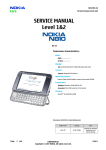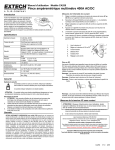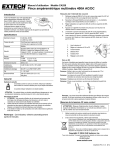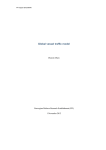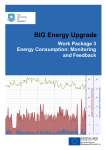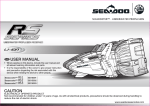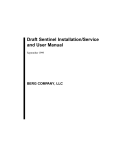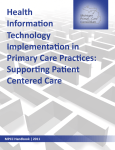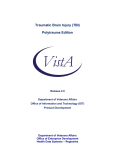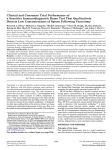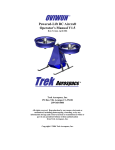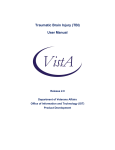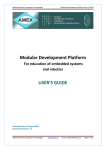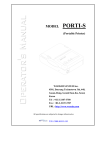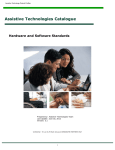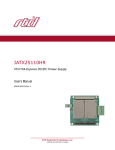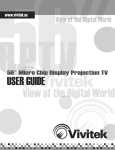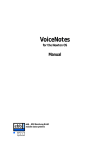Download Comprehensive Review of the Nokia N810 Internet Tablet
Transcript
Comprehensive Review of the Nokia N810 Internet Tablet Introduction So what is the Nokia N810? Is it a tablet computer? A PDA? An Internet appliance? An E-Book reader? A MP3 player? A portable video player? Well, it has aspects of all of those devices and more. However, it is marketed as a convenient, wireless, web browsing appliance. As you will soon see, you can do much more than that with it... The older N770 on the left next to the new N810 on the right and The entry price was targeted at $479, quite a dollar bill (for scale). a bit higher than the debut price of the N770 which was $400. Expect the prices to drop, however. The target audience for the Nokia Internet Tablets is people who want to quickly and wirelessly jump on the web to research something or communicate, without having to go to a larger machine or laptop. The N810 extends the convenience of the net in ways no smart phone or PDA ever has. In the Box In the pretty packaging you will find the N810, a very slim battery, a stereo headset with drop (necklace style) mic, a USB cable, a car mount, a tiny charger, a screen wipe cloth, a soft case, a spare stylus, and an instruction poster. Yes, I said “poster”. Unfortunately, they didn't include a real user's manual. There is a manual PDF and help file on the N810, but it would be nice to have a real manual or even a DVD video included. The padded slip-on case is light and will give scratch and shock protection, although it has no hard insert, so there is no crush protection for the screen. The charger is the same model as included with the 770 and 800 models. Case The brushed metal case is fantastically slim. This is all the more apparent when you try to insert the battery. The back door is a very thin sheet of metal that has to be removed. It is a bit tricky, but not all that difficult. The unit is heavier than expected. Nokia finally added one of my #1 suggestions from the 770 days- an adjustable kick-out stand. It is fantastic! The stand has three semi-locking positions for three different viewing angles. Physical Tour On the right side on the unit is a stereo + mic 1/8” jack, the charging port, the right speaker, and the USB connector. Unfortunately, the USB connector is NOT a mini-USB, it is a newer, flat type called “micro-B” that will require the use of the included cable. The long-overdue and much appreciated built-in stand On the top right is the hidden stylus, which slides out to the right. Next to it is the sliding lock switch, a wonderful new feature. It is a spring-loaded, sliding switch to lock the unit screen. This was something sorely missed on the 770. And, although it works, I consider it a flawed design. The button must be slid the wrong way (to the left). It can only be slid with a fingernail, and the switch is on the right, so you can't use your right hand to unlock it (single handedly). The power button is near the center, followed by the standard zoom and full screen controls on the left. It is a bit difficult to use the screen controls when the keyboard is extended. The left side has nothing but the left speaker. The bottom has the rear battery door release and the miniSD slot, which is covered by a tethered rubber cover. Supposedly you can use up to a 8GB card in the slot. There is also a tiny hole, which I believe is the built-in microphone. The front of the unit is mostly the screen. To the left of the screen is the multifunction LED indicator, the ambient light sensor, the 0.3 megapixel camera lens, and two navigation buttons (“swap” and “escape”). Keyboard Of course, one of the most exciting features added with the N810 is the slide out keyboard. Technically, the keyboard doesn't slide out, the screen slides up, revealing the keyboard below. There is a tiny 5-way nav cluster on the left, with a menu button below. On the right is a 4-row QWERTY keyboard. The missing 5th row would contain the numbers and symbols, which are remapped below and require using the “Fn” key. One of the best features of the keyboard is that it is automatically backlit. Using the keyboard is not difficult, although the keys are very flat and offer almost no tactile feedback. It is much faster than using the (still available) on-screen keyboard. Power The screen slides up revealing a backlit keyboard and nav controls The included BP-4L battery is the same battery Nokia uses in other phone models, so it will be easy to obtain replacements or spares and at a reasonable cost. It charges quickly and lasts over a week in “standby” mode and anywhere from 3 to 6 hours “in use”, depending on what you are doing. The specs claim 10 hours of music playback (I assume they mean local files). There is a nice icon indicating the battery status and touching it will display an estimate of remaining time based on usage. The unit takes about 30 seconds to boot from power off, but is available instantly when in ultra-low power standby. Screen True to the entire Internet Tablet line, the N810's backlit, 800x480 LCD screen is simply fantastic. It is sharp, clear, high-res, high-contrast, and very bright. But the best feature of all is the new automatic ambient light sensor which adjusts the screen brightness based on the lighting in the room. The user can still manually control the bias of the brightness and how much time before it dims and then shuts off. I am told the screen is brighter than the previous two models. And the big surprise- the shift to a transflective display that can be read in sunlight! The default look of the desktop with the connections menu open The passive touch screen feature is identical to previous models and thus can be used with your finger or the included stylus. Operating System & Operation The N810 is powered by Linux running on an TI2420 OMAP 400Mhz processor. The distribution is based on “Maemo” an open-source, community-driven project. Nokia brands the OS “OS2008”, which follows “OS2007” and “OS2006” and “OS2005”. It is a Debian derivative and primarily uses “.deb” packages, which can be downloaded and installed directly from the tablet. In the past, OS upgrades have been free. Having double the memory and a much faster processor than the N770 makes using the N810 much more pleasing. Gone is most of the “hesitation” and long waits for applications to load and run. The main menu- one of three flyouts The Internet Tablet uses a unique window manager to make operation simpler with the limited screen space. Since it uses a touch screen, most entry is via intuitive, screen-touching and dragging. Click on any place that requires text entry gives the user a choice of using the included keyboard, handwriting recognition or an on-screen keyboard. All work well, although the handwriting recognition is rudimentary. Connectivity Nokia N810 Basic Specs The N810 has a very well designed connections manager and has no trouble quickly connecting to WiFi or bluetooth networks. I was able to 14mm/ 0.55” thick pair it with my Sprint Treo 700p in only a few minutes and save all the settings for quick access. I stumbled a bit connecting to my home WiFi Weight: 226g/7.97oz only because I didn't realize you have to enter the WEP key as hex (it 4.13” 800x480 LCD, 65K colors should indicate that on the screen). Jumping from one connection to Ambient light sensor another is extremely easy and the connection icon will show signal Variable pressure touch screen strength. ● L:72mm/2.83” W:128mm/5” ● ● ● ● ● ● 400Mhz TI Omap 2420 CPU ● 128MB DDR RAM ● 256MB OS flash memory ● 2GB user internal flash memory included ● MiniSD cardslot upto 8GB The file manager will show bluetooth as a mounted filesystem, as well as “Shared Folders”, which is their way of saying “SMB” (Samba) network file sharing. So you can copy, read, write or stream files from the WiFi network, also. Memory ● 802.11b/g & bluetooth 2.0 The N810 has 128MB of internal DDR RAM that it keeps powered as long as the unit is on or in “standby”. Working with this is 256MB of flash that Up to 14 day standby, 10 hours it uses as the primary “hard drive” primarily in a “jffs2” filesystem. It also has an internal, non-removable 2 GB flash formatted as VFAT and music play, 5 day always online, 4 hours continuous use titled “Internal Memory Card”. The 2GB is mostly consumed by map data for the GPS and some sample videos. The remaining 200MB is free to 640x480 web camera store other user files such as video, pictures, music, etc. You can delete 3.5mm stereo headphone/mic unwanted map data to increase available storage space when necessary USB 2.0. micro-b (and redownload what you need). ● 1500mAh Li-polymer battery ● ● ● ● ● GPS If you insert a miniSD flash card, it is automatically mounted and available in the file tree as “External Memory Card”. It is possible to reformat either the external or internal “cards” via a menu option. Despite Nokia's specs “up to an 8GB card”, other sources are indicate support for even larger cards later. ● Stereo speakers + mono mic When connected to a computer via USB, the N810 appears as a mass-storage device, working perfectly with Linux and other operating systems. The internal flash memory and external flash cards appear as two separate “drives”. While connected via USB, the flash memory is not visible on the N810, itself. Copying files is fast and easy. GPS Yes, they finally added a GPS to the Internet Tablet! And it really works. Included are three map sets- Canada, USEast, and US-West. Others can be downloaded from the Tablet. It takes anywhere from several seconds to a few Full-screen GPS map application in 2D mode minutes for the N810 to acquire the satellites. Once it has enough satellite fixes, you are taken to your location on a map and will be shown your speed and position, road names, and places of interest. Even with no satellites, you can still browse and search the maps. The 3D view is interesting, but essentially useless, because it stops displaying all road names! You can look up locations by address or point of interest, but sometimes the “list as you type” isn't fast enough, so it can be rather frustrating. During one search I had to kill the process after two minutes of apparently being stuck. I will assume these bugs will be fixed in software updates. During my tests, the indicated position lagged about 25 to 30 feet behind where I really was. It didn't seem to matter how many satellites it could see. But the unit was fast at updating the screen- several per second, and the controls worked well. Don't expect routing/driving assistance unless you decide to pay for a subscription/unlock fee to use the included (but deactivated) voice guidance and directions. Three years costs $120. Web Browser The N810 is the first Tablet to move away from the mini-Opera based browser and include the new Mozilla “Microb” browser. Unlike Opera, Microb is an open-source project. The browser is quite usable, and perhaps more stable than the older Opera one. Full “Ajax” support means even complex web sites tend to render and work fine. The browser includes all the expected features, including bookmarks, reloading, find, reformatting to fit the screen better, history, cookie control, and even optional (additional) plugins. Mozilla Microb web browser on one of the most important web sites The great news is that the N810 supports and includes Flash9. Yes, it will work with Youtube. The bad news is that by supporting Flash, you get all the crappy animated ads and whiz-bang stuff that uses lots of bandwidth (which is bad when using a bluetooth connection to a phone, instead of WiFi) and slows down the machine.... a lot. On some sites, the N810 is almost unusable because it gets so bogged down with Flash rendering. What is desperately needed is a “Flash overlay” or “Flashblock” plugin that will show placeholders without downloading Flash sections of a site until the user clicks on those parts. Hopefully with the open framework of Microb, this feature should show up soon. Multimedia Nokia includes several short videos, plus two full-length music videos, and several songs, to show off the N810's multimedia capabilities. Unlike the 770, the N810 can play back full-screen video, at high framerates, at a reasonable quality, with no stumbling or hesitation. Keep in mind this is still only 400x240 resolution or less being “scaled up”, so don't expect the sharpness of DVD quality. But also remember that most portable DVD players and other small devices also do not display DVD's 700x480 (or so) resolution. The included media player application is rather simple and lacks easy navigation control during playback of video. It also doesn't provide enough detail about what type of file is being played (frame rate, res, bitrate, codecs). But the user will be able to obtain third-party players (like Mplayer) that will support more file formats and user fine-tuning control. Audio quality is excellent too, and playing MP3's is easy (although there is no Vorbis support). The included Rhapsody client works flawlessly. I already had an account and after logging in, I was listening to very highquality “radio” mixes from Rhapsody- far superior to traditional “Internet Radio”, which it also supports. Trying to actually transcode video to a format that will Image viewer- the N810 is the best portable play on the N810 is a challenge, but no more so than with photo viewer you can get the previous Internet Tablets or many other devices. Nokia is trying to help- by offering a beta of software to convert video, but it is MS-Windows only.... something that many Tablet owners will be very unhappy about. For everyone else, “mencoder” works just fine, but you have to get the aspect ratio correct or it simply will not play the resulting videos. There are also applications for viewing photos/pictures and PDF files. The quality and resolution of the screen makes viewing photos a pleasure- far better than any Palm or Pocket-PC I have ever used. Messaging Nokia includes an Email application, a Chat application, and an RSS feed reader. The IM (chat) only supports Google Talk, Jabber, and SIP, so I didn't bother testing it. Instead, I downloaded and installed Pidgin (Gaim) and that works great. If you are into voice- there is “internet call”, “Gizmo”, and Skype. Any of them can turn your N810 into an Internet Phone. Gizmo also supports using the built-in webcam for video conferencing. At this time, I have no interest in those, so I have not reviewed them. Other Applications There is a file manager, calculator, clock, notes (text), sketch (simple drawing), search, backup/restore, settings, and Xterm. Yes- they actually included an Xterm application. Clicking on it will give you user-level access to a shell with busybox. If you like games, they included chess, blocks, mahjong, and marbles with several other games already available on the Internet for download. What's Missing Nokia included the xterm application in OS2008, so no need to download and install it Unfortunately, just like with the 770 and 800, Nokia did not include any real PIM/PDA applications (comprehensive contact management, calendar, reminders, todo lists, expense tracker). There is also no included way to use the built-in camera to take and store simple photos much less videos. Nor is there a voice-recorder. My research also shows that it has a variable pressure sensitive screen, but none of the applications make use of that feature at this time. Nokia removed the FM tuner that was present in the N800. It would have been nice to have an infrared LED emitter to use the 810 as a remote control for home entertainment systems or share files with Palm based machines. Conclusion There is no question that Nokia has plans for Linux and Internet Tablets. The N810 is the third model released over the last few years (770: 11/2005, N800 1/2007, N810 11/2007). The rapid release of the N810 so soon after the N800 took most of the Internet Tablet community by surprise and had to represent a significant investment in retooling. The next logical step is to add a internal phone to the Internet Tablet, making it truly a “does it all” device. However, developing space in the unit for a phone module will be a challenge. But the bigger challenge will be selecting a phone service provider that will make people happy. Unofficial channels Mark A. Davis is the Director of Information Systems at Lake indicate Nokia might release a WiMax (Sprint?) Taylor Transitional Care Hospital for 18 years in Norfolk, Virginia, enabled tablet in 2008 for broader network which uses Linux extensively (www.laketaylor.org). He also taught connectivity. Linux courses at a local college for three years, is a Charter For it's weight and size, there isn't a more powerful or flexible device on the market. Backed by a strong company (Nokia), the Internet Tablet is here to stay and the N810 is a fantastic machine. It is the most “open”, neat, and useful gadget you can fit in your pocket. -Mark A. Davis Member of the TideWater Unix User's Group (www.TWUUG.org), a Member of the Healthcare Information & Management Systems Society (www.himss.org), and a Pioneer Member of the Electronic Freedom Foundation (www.eff.org). He may be contacted via Email: [email protected] or via phone at 757-461-5001x431 Article copyrighted 2007 by Mark A. Davis. This article may be freely redistributed but only in it's entirety and with full attribution and copyright notice intact. Ver 1.0





